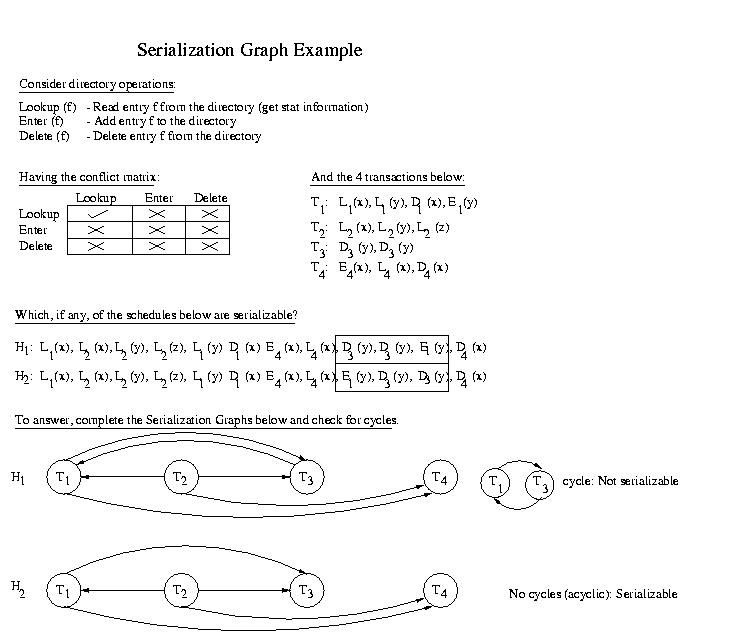Return to the lecture notes index
February 20, 2008 (Lecture 16)
Reading
- Coulouris, et al: 12.4.2 - 12.4.8, 13.4-13.7
Safe Schedules
Transactions must execute as if in isolation. That doesn't
necessarily prohibit concurrency among transactions -- it just
implies that this concurrency shouldn't have any effect on the
results or the state of the system. In fact, as long as the results
and other state are the same as for some serial execution of the
transactions, the transactions can be interleaved, executed concurrently,
or btoh.
Transaction processing systems (TPSs) contain a
transaction scheduler that dispatches the transactions and
allows them to execute. This scheduler isn't necessarily FIFO,
and it doesn't necessarily dispatch only one at a time. Instead,
it tries to maximize the amount of work that gets done. One
popular measure of the performance of a TPS is the number of
transactions per second (TPS). Yes, unfortuantely, TPS
is also its abbreviation.
In discussing the scheduler, it is helpful to ask the question,
"What is a schedule?" It is an ordering of events. The transaction
scheduler's job is to execute the indivdual operations that compose
the transactions in an order that is efficient and preserves the property
of isolation. As a result, it is the schedule of individual operations
that is our concern.
Safe Concurrency: Serial Schedules and Serializability
A serial schedule is a schedule that executes all of the operations
from one transaction, before moving on to the operations of another
transaction. In other words the transactions are executed in series.
An interleaved schedule is a schedule in which the operations
of an individual transaction are executed in order with respect to the
same transaction, but without the restriction that the transactions
be scheduled as a whole. In other words, interleaving allows the scheduling
of any operation, as long as the operations of the same transaction are
not reversed.
Some interleaved schedules are safe, whereas other way result in violations
of the isolation property. Safe interleaved schedules are known as
serializable schedules. This is because an interleaved schedule is
only safe if it is equivalent to a serial schedule -- that's why
they call it serial-izable.
What did I mean when I wrote, is equivalent? An interleaved
schedule is equivalent to a serial schedule, if transactions which
containing conflicting operations are not interleaved. Operations are
said to be conflicting if the results differ depending on their
order.
This means that an interleaved schedule is serializable if, and only if,
each pair of operations occurs in the same order as they would in
some serial schedule.
Serializability Graphs
We can see if a schedule is serializable by building a serialzability
graph. The Fundamental Theorem of Serializability states
that a schedule H is serializable, if and only if, SG(H) is acyclic.
So how do we build a serializability graph?
- Create a node for each transaction
- Draw an edge from Ti to Tj if and only if
some operation in Ti conflicts with an operation in
Tj and the operation in Ti occurs before
the operation in Tj in the given schedule. The example
belwo will make this a bit clearer.
Example: Directory Operations

Let's take a careful look and make sure that we understand the source of
the problem in schedule H1. The fragment below shows only
the relevant portion of the schedule:
. . . L1(x) . . . L1(y)
. . . D3(y) . . . D3(y)
. . . E1(y) . . .
If we look at the fragment, we see that L1(x) conflicts
with D3(y). Since L1(x) occurs before
D3(y) in H1, an equivalent serial schedule
must execute T1 before T3. But if we look further
ahead in the trace we see that D3(y) occurs before
E1(y). Similarly, since these operations conflict, it
implies that T3 must occur before T1 in an
equivalent serial schedule. Both of these statments cannot be true.
If T1 executes before T3, T3 cannot
execute before T1. This schedule cannot be converted to an
equivalent serial schedule. It is not serializable -- it is not safe.
Remember two-phase locking from last class? Although it is handled by the
transaction manager, it does allow for the interleaving of operations.
Are the schedules that it generates serializable?
The answer to this is yes. Two-phase locking ensures that transactions
which use the same objects cannot execute concurrently. This ensures
that no conflicts can happen. If interleaved transactions don't share, we
know that we are safe.
Two phase locking ensured serialzable schedules using what is known as
inconsistency prevention. Prevention techniques constrain the
transactions to ensure that conflicting operations can never happen.
Two-phase locking does this by preventing transactions that share
objects from executing concurrently. Although inconsistency prevention
is effective, it is also expensive. Perfectly safe sharing may be
prevented -- this unnecessarily reduces concurrency.
